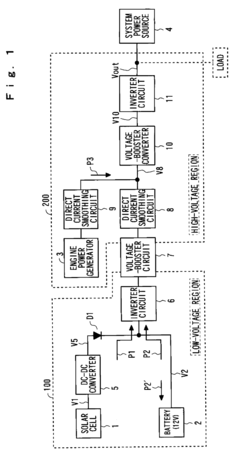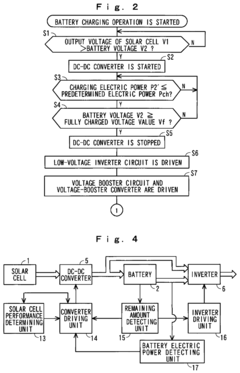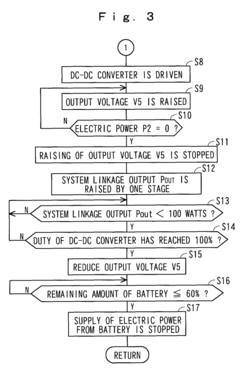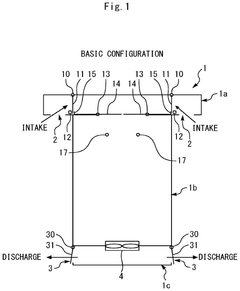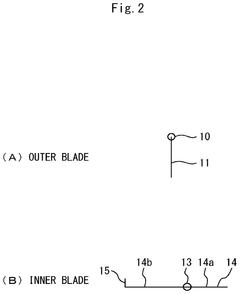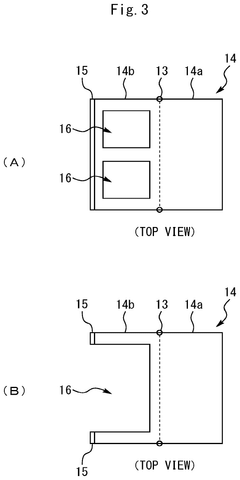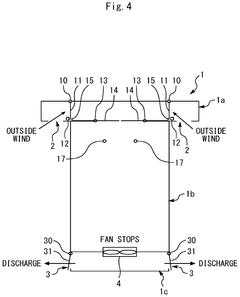How to Enhance Solar Inverter Performance in Cloudy Weather?
JUL 17, 20259 MIN READ
Generate Your Research Report Instantly with AI Agent
Patsnap Eureka helps you evaluate technical feasibility & market potential.
Solar Inverter Challenges in Cloudy Conditions
Solar inverters face significant challenges in cloudy conditions, which can substantially impact their performance and efficiency. The primary issue stems from the reduced and fluctuating solar irradiance during overcast weather. This variability in sunlight intensity leads to inconsistent power generation, making it difficult for inverters to maintain optimal operation.
One of the key challenges is the rapid fluctuation in power output caused by passing clouds. These sudden changes can lead to voltage and frequency instabilities in the grid, potentially triggering protective shutdowns in the inverter. This not only reduces overall energy production but also puts stress on the inverter components, potentially shortening their lifespan.
Another critical issue is the reduced efficiency of solar panels in low-light conditions. While modern solar cells can still generate electricity in diffuse light, the voltage produced is often below the inverter's minimum operating threshold. This results in frequent start-stop cycles of the inverter, reducing its overall efficiency and increasing wear on the system.
The mismatch between the inverter's capacity and the actual power generated during cloudy periods presents another challenge. Most inverters are sized based on the peak power output of the solar array. However, in cloudy conditions, they often operate well below their rated capacity, leading to suboptimal performance and reduced conversion efficiency.
Moreover, the unpredictable nature of cloud cover makes it challenging to implement effective Maximum Power Point Tracking (MPPT) algorithms. These algorithms are crucial for optimizing the power output of solar panels, but their effectiveness is compromised when rapid changes in irradiance occur, leading to potential energy losses.
The accumulation of moisture on solar panels during cloudy weather can also affect inverter performance. Water droplets can cause light refraction and reflection, further reducing the amount of sunlight reaching the solar cells. This not only decreases power generation but can also lead to inconsistent input to the inverter, making power conversion more challenging.
Lastly, the extended periods of low power generation during prolonged cloudy weather can lead to increased standby losses in the inverter. These losses, while relatively small, can accumulate over time, affecting the overall efficiency of the solar power system, especially in regions prone to frequent overcast conditions.
One of the key challenges is the rapid fluctuation in power output caused by passing clouds. These sudden changes can lead to voltage and frequency instabilities in the grid, potentially triggering protective shutdowns in the inverter. This not only reduces overall energy production but also puts stress on the inverter components, potentially shortening their lifespan.
Another critical issue is the reduced efficiency of solar panels in low-light conditions. While modern solar cells can still generate electricity in diffuse light, the voltage produced is often below the inverter's minimum operating threshold. This results in frequent start-stop cycles of the inverter, reducing its overall efficiency and increasing wear on the system.
The mismatch between the inverter's capacity and the actual power generated during cloudy periods presents another challenge. Most inverters are sized based on the peak power output of the solar array. However, in cloudy conditions, they often operate well below their rated capacity, leading to suboptimal performance and reduced conversion efficiency.
Moreover, the unpredictable nature of cloud cover makes it challenging to implement effective Maximum Power Point Tracking (MPPT) algorithms. These algorithms are crucial for optimizing the power output of solar panels, but their effectiveness is compromised when rapid changes in irradiance occur, leading to potential energy losses.
The accumulation of moisture on solar panels during cloudy weather can also affect inverter performance. Water droplets can cause light refraction and reflection, further reducing the amount of sunlight reaching the solar cells. This not only decreases power generation but can also lead to inconsistent input to the inverter, making power conversion more challenging.
Lastly, the extended periods of low power generation during prolonged cloudy weather can lead to increased standby losses in the inverter. These losses, while relatively small, can accumulate over time, affecting the overall efficiency of the solar power system, especially in regions prone to frequent overcast conditions.
Market Demand for Efficient Solar Energy Systems
The global solar energy market has been experiencing significant growth, driven by increasing environmental concerns and the push for sustainable energy solutions. However, the demand for efficient solar energy systems, particularly those that can perform well in cloudy weather conditions, has become a critical focus for the industry. This demand is fueled by the need to maximize energy production in regions with variable weather patterns and to improve the overall reliability of solar power systems.
In many parts of the world, cloudy weather can significantly impact the performance of solar panels, reducing their efficiency and power output. This challenge has created a strong market demand for solar inverters that can enhance performance under such conditions. Consumers, businesses, and utility companies are increasingly seeking solutions that can maintain high energy yields even when sunlight is not optimal.
The market for efficient solar energy systems is also driven by the growing adoption of distributed energy resources (DERs) and the integration of solar power into smart grids. As more residential and commercial properties install rooftop solar systems, there is a rising need for inverters that can optimize power conversion and maintain grid stability, especially during periods of cloud cover.
Furthermore, the push for grid resilience and the increasing frequency of extreme weather events have heightened the importance of solar systems that can perform reliably under various atmospheric conditions. This has led to a surge in demand for advanced inverter technologies that can adapt to changing weather patterns and maintain consistent power output.
The economic factors also play a significant role in driving market demand. As the cost of solar technology continues to decrease, the focus has shifted towards improving the return on investment through enhanced system efficiency. Consumers and investors are looking for solar solutions that can generate more power over the system's lifetime, even in less-than-ideal weather conditions.
In addition, government policies and incentives aimed at promoting renewable energy adoption have further stimulated the demand for high-performance solar systems. Many countries have set ambitious targets for solar energy capacity, creating a favorable environment for innovations in solar inverter technology that can address the challenges posed by cloudy weather.
The market is also seeing increased interest from regions traditionally considered less suitable for solar energy due to their climate. These areas are now exploring solar options, driving the need for inverters that can perform efficiently in diverse weather conditions, including frequent cloud cover.
In many parts of the world, cloudy weather can significantly impact the performance of solar panels, reducing their efficiency and power output. This challenge has created a strong market demand for solar inverters that can enhance performance under such conditions. Consumers, businesses, and utility companies are increasingly seeking solutions that can maintain high energy yields even when sunlight is not optimal.
The market for efficient solar energy systems is also driven by the growing adoption of distributed energy resources (DERs) and the integration of solar power into smart grids. As more residential and commercial properties install rooftop solar systems, there is a rising need for inverters that can optimize power conversion and maintain grid stability, especially during periods of cloud cover.
Furthermore, the push for grid resilience and the increasing frequency of extreme weather events have heightened the importance of solar systems that can perform reliably under various atmospheric conditions. This has led to a surge in demand for advanced inverter technologies that can adapt to changing weather patterns and maintain consistent power output.
The economic factors also play a significant role in driving market demand. As the cost of solar technology continues to decrease, the focus has shifted towards improving the return on investment through enhanced system efficiency. Consumers and investors are looking for solar solutions that can generate more power over the system's lifetime, even in less-than-ideal weather conditions.
In addition, government policies and incentives aimed at promoting renewable energy adoption have further stimulated the demand for high-performance solar systems. Many countries have set ambitious targets for solar energy capacity, creating a favorable environment for innovations in solar inverter technology that can address the challenges posed by cloudy weather.
The market is also seeing increased interest from regions traditionally considered less suitable for solar energy due to their climate. These areas are now exploring solar options, driving the need for inverters that can perform efficiently in diverse weather conditions, including frequent cloud cover.
Current Limitations of Solar Inverters in Low Light
Solar inverters play a crucial role in converting DC power generated by solar panels into AC power for use in homes and businesses. However, their performance is significantly impacted by low light conditions, particularly in cloudy weather. This limitation poses a significant challenge to the efficiency and reliability of solar energy systems.
One of the primary limitations of current solar inverters in low light conditions is their reduced efficiency. As the amount of sunlight decreases, the voltage output from solar panels drops, making it difficult for inverters to maintain optimal power conversion. This results in a substantial decrease in overall system performance, with some inverters struggling to operate at all below certain light thresholds.
Another key issue is the inability of many inverters to effectively track the maximum power point (MPP) under rapidly changing light conditions. Cloud cover can cause frequent and sudden fluctuations in solar irradiance, requiring inverters to quickly adjust their operating parameters. However, conventional MPP tracking algorithms often fail to respond swiftly enough, leading to energy losses and reduced power output.
The start-up threshold of solar inverters also presents a significant limitation in low light scenarios. Many inverters require a minimum DC input voltage to begin operation, which may not be reached during heavily overcast days. This can result in extended periods of zero power production, even when some energy could potentially be harvested.
Furthermore, the voltage range of solar inverters is often optimized for standard sunlight conditions, limiting their ability to handle the lower voltages produced by panels in cloudy weather. This mismatch can lead to premature shutdown of the inverter or operation in suboptimal voltage ranges, further reducing system efficiency.
The issue of harmonics and power quality also becomes more pronounced in low light conditions. As inverters struggle to maintain stable output with fluctuating input, they may introduce higher levels of harmonic distortion into the grid. This can potentially violate grid connection standards and reduce the overall quality of power supplied.
Lastly, the energy storage capabilities of current solar inverter systems are often inadequate to compensate for extended periods of low light. While some hybrid inverters incorporate battery storage, the capacity and integration of these systems are frequently insufficient to maintain consistent power output during prolonged cloudy periods.
Addressing these limitations requires innovative approaches in inverter design, control algorithms, and system integration. Enhancing the performance of solar inverters in cloudy weather is crucial for improving the reliability and economic viability of solar energy systems, particularly in regions with variable weather patterns.
One of the primary limitations of current solar inverters in low light conditions is their reduced efficiency. As the amount of sunlight decreases, the voltage output from solar panels drops, making it difficult for inverters to maintain optimal power conversion. This results in a substantial decrease in overall system performance, with some inverters struggling to operate at all below certain light thresholds.
Another key issue is the inability of many inverters to effectively track the maximum power point (MPP) under rapidly changing light conditions. Cloud cover can cause frequent and sudden fluctuations in solar irradiance, requiring inverters to quickly adjust their operating parameters. However, conventional MPP tracking algorithms often fail to respond swiftly enough, leading to energy losses and reduced power output.
The start-up threshold of solar inverters also presents a significant limitation in low light scenarios. Many inverters require a minimum DC input voltage to begin operation, which may not be reached during heavily overcast days. This can result in extended periods of zero power production, even when some energy could potentially be harvested.
Furthermore, the voltage range of solar inverters is often optimized for standard sunlight conditions, limiting their ability to handle the lower voltages produced by panels in cloudy weather. This mismatch can lead to premature shutdown of the inverter or operation in suboptimal voltage ranges, further reducing system efficiency.
The issue of harmonics and power quality also becomes more pronounced in low light conditions. As inverters struggle to maintain stable output with fluctuating input, they may introduce higher levels of harmonic distortion into the grid. This can potentially violate grid connection standards and reduce the overall quality of power supplied.
Lastly, the energy storage capabilities of current solar inverter systems are often inadequate to compensate for extended periods of low light. While some hybrid inverters incorporate battery storage, the capacity and integration of these systems are frequently insufficient to maintain consistent power output during prolonged cloudy periods.
Addressing these limitations requires innovative approaches in inverter design, control algorithms, and system integration. Enhancing the performance of solar inverters in cloudy weather is crucial for improving the reliability and economic viability of solar energy systems, particularly in regions with variable weather patterns.
Existing Solutions for Cloudy Weather Performance
01 Efficiency improvement techniques
Various methods are employed to enhance the efficiency of solar inverters, including advanced control algorithms, improved power conversion circuits, and optimized component selection. These techniques aim to maximize energy conversion from DC to AC, reduce power losses, and increase overall system performance.- Efficiency improvement techniques: Various methods are employed to enhance the efficiency of solar inverters, including advanced control algorithms, improved power conversion circuits, and optimized component selection. These techniques aim to maximize power output and minimize energy losses during the DC to AC conversion process.
- Thermal management and cooling systems: Effective thermal management is crucial for maintaining optimal solar inverter performance. This includes innovative cooling systems, heat dissipation techniques, and temperature monitoring mechanisms to prevent overheating and ensure stable operation under various environmental conditions.
- Grid integration and power quality: Solar inverters are designed to seamlessly integrate with the power grid while maintaining high power quality. This involves advanced grid synchronization techniques, harmonic reduction methods, and reactive power control to ensure compliance with grid standards and regulations.
- Monitoring and diagnostics: Sophisticated monitoring and diagnostic systems are incorporated into solar inverters to track performance, detect faults, and facilitate preventive maintenance. These systems may include real-time data analysis, remote monitoring capabilities, and predictive maintenance algorithms.
- Smart features and connectivity: Modern solar inverters are equipped with smart features and connectivity options to enhance their functionality and integration with other systems. This includes IoT capabilities, communication protocols for data exchange, and compatibility with energy management systems and smart grids.
02 Maximum Power Point Tracking (MPPT)
MPPT algorithms are implemented in solar inverters to continuously adjust the operating point of solar panels, ensuring maximum power output under varying environmental conditions. Advanced MPPT techniques improve energy harvesting efficiency and overall system performance.Expand Specific Solutions03 Grid integration and stability
Solar inverters incorporate features to enhance grid integration and stability, such as reactive power control, voltage regulation, and fault ride-through capabilities. These functionalities improve the overall performance of solar power systems and their compatibility with the electrical grid.Expand Specific Solutions04 Thermal management and reliability
Effective thermal management techniques are implemented to improve the reliability and longevity of solar inverters. This includes advanced cooling systems, temperature monitoring, and intelligent power management to optimize performance under various operating conditions.Expand Specific Solutions05 Monitoring and diagnostics
Solar inverters incorporate advanced monitoring and diagnostic features to track performance, detect faults, and optimize maintenance. These systems may include remote monitoring capabilities, data logging, and predictive maintenance algorithms to enhance overall system reliability and efficiency.Expand Specific Solutions
Key Players in Solar Inverter Industry
The solar inverter performance enhancement market in cloudy weather is in a growth phase, driven by increasing renewable energy adoption and the need for efficient solar power generation in diverse climatic conditions. The market size is expanding, with a projected CAGR of 15-20% over the next five years. Technologically, the field is advancing rapidly, with key players like Huawei Digital Power, Sungrow Power Supply, and Siemens Corp leading innovation. These companies are developing advanced algorithms, AI-powered forecasting, and smart grid integration to optimize inverter performance in low-light conditions. Emerging players such as ZTE Corp and Midea Group are also entering the market, focusing on IoT-enabled solutions and energy storage integration to address cloudy weather challenges.
Huawei Digital Power Technologies Co Ltd
Technical Solution: Huawei's AI-powered Smart PV Solution enhances solar inverter performance in cloudy weather through advanced algorithms and real-time data analysis. The system utilizes machine learning to predict weather patterns and optimize power output. It employs Maximum Power Point Tracking (MPPT) technology to continuously adjust the operating point of solar panels, maximizing energy harvest even in low-light conditions[1]. The solution also incorporates string-level optimization, allowing for better performance in partially shaded scenarios. Huawei's smart inverters can rapidly respond to sudden changes in irradiance, maintaining grid stability and power quality[2]. The company's FusionSolar management platform provides comprehensive monitoring and intelligent O&M, further improving overall system efficiency.
Strengths: Advanced AI algorithms for weather prediction and power optimization; Rapid response to changing conditions; Comprehensive monitoring system. Weaknesses: Potentially higher initial cost; Reliance on complex software that may require regular updates.
Sungrow Power Supply Co., Ltd.
Technical Solution: Sungrow's approach to enhancing solar inverter performance in cloudy weather focuses on their innovative "1+X" modular inverter design. This system allows for flexible capacity expansion and improved reliability. Their inverters utilize advanced MPPT algorithms specifically designed for low-irradiance conditions, enabling efficient energy harvesting during cloudy days[3]. Sungrow's inverters also feature reactive power compensation capabilities, which help maintain grid stability during fluctuating weather conditions. The company's cloud-based monitoring platform, iSolarCloud, provides real-time performance data and predictive maintenance alerts, allowing for proactive system optimization. Additionally, Sungrow has developed a patented anti-PID (Potential Induced Degradation) technology that helps maintain panel efficiency over time, particularly beneficial in humid or cloudy environments[4].
Strengths: Modular design for scalability; Specialized algorithms for low-irradiance conditions; Advanced monitoring and maintenance features. Weaknesses: May require more complex installation; Potential for higher upfront costs due to advanced features.
Core Innovations in Solar Inverter Efficiency
Power source apparatus and control method of the power source apparatus
PatentInactiveUS7906934B2
Innovation
- A power source apparatus incorporating a DC-DC converter, battery, and inverter, where the DC-DC converter charges the battery when its level is low and supplies power from the solar cell when output is high, switching between solar cell and battery power sources to maintain stability, and using a voltage-booster converter to optimize energy use.
Wind pressure type shutter for outdoor switchboard
PatentActiveUS20240332919A1
Innovation
- A dual-structure wind pressure type shutter with a first flap that closes vertically and a second flap that locks the first flap in place, utilizing a negative pressure generated by a cooling fan to open the flow path, ensuring waterproofness and dustproofness without the need for sensors or control devices.
Grid Integration Strategies for Intermittent Solar Power
Grid integration strategies for intermittent solar power are crucial for enhancing solar inverter performance in cloudy weather. These strategies focus on managing the variability and uncertainty associated with solar energy production, particularly during periods of reduced sunlight.
One key approach involves advanced forecasting techniques. By utilizing sophisticated weather prediction models and real-time data from multiple sources, grid operators can better anticipate fluctuations in solar power output. This improved forecasting allows for more efficient scheduling of other power sources to compensate for solar intermittency.
Energy storage systems play a vital role in grid integration. Battery storage technologies, such as lithium-ion batteries or flow batteries, can store excess solar energy during peak production periods and release it when solar output decreases. This helps to smooth out the power supply and maintain grid stability during cloudy conditions.
Smart grid technologies are essential for effective integration. These include advanced monitoring and control systems that can rapidly respond to changes in solar power generation. Demand response programs, which incentivize consumers to adjust their electricity usage based on grid conditions, can help balance supply and demand during periods of low solar output.
Microgrids and distributed energy resources offer another strategy for managing intermittent solar power. By creating localized power systems that can operate independently or in conjunction with the main grid, microgrids can enhance resilience and flexibility in power distribution. This approach is particularly beneficial in areas prone to frequent cloud cover or extreme weather events.
Grid-scale power electronics, such as advanced inverters and power converters, play a crucial role in maintaining power quality and grid stability. These devices can provide reactive power support, voltage regulation, and frequency control, helping to mitigate the impact of fluctuating solar power on the grid.
Lastly, regional and inter-regional grid interconnections can help balance the variability of solar power across larger geographical areas. By linking grids across diverse climate zones, the impact of localized cloud cover can be mitigated, as solar production in one area can compensate for reduced output in another.
One key approach involves advanced forecasting techniques. By utilizing sophisticated weather prediction models and real-time data from multiple sources, grid operators can better anticipate fluctuations in solar power output. This improved forecasting allows for more efficient scheduling of other power sources to compensate for solar intermittency.
Energy storage systems play a vital role in grid integration. Battery storage technologies, such as lithium-ion batteries or flow batteries, can store excess solar energy during peak production periods and release it when solar output decreases. This helps to smooth out the power supply and maintain grid stability during cloudy conditions.
Smart grid technologies are essential for effective integration. These include advanced monitoring and control systems that can rapidly respond to changes in solar power generation. Demand response programs, which incentivize consumers to adjust their electricity usage based on grid conditions, can help balance supply and demand during periods of low solar output.
Microgrids and distributed energy resources offer another strategy for managing intermittent solar power. By creating localized power systems that can operate independently or in conjunction with the main grid, microgrids can enhance resilience and flexibility in power distribution. This approach is particularly beneficial in areas prone to frequent cloud cover or extreme weather events.
Grid-scale power electronics, such as advanced inverters and power converters, play a crucial role in maintaining power quality and grid stability. These devices can provide reactive power support, voltage regulation, and frequency control, helping to mitigate the impact of fluctuating solar power on the grid.
Lastly, regional and inter-regional grid interconnections can help balance the variability of solar power across larger geographical areas. By linking grids across diverse climate zones, the impact of localized cloud cover can be mitigated, as solar production in one area can compensate for reduced output in another.
Environmental Impact of Advanced Solar Technologies
The environmental impact of advanced solar technologies, particularly in the context of enhancing solar inverter performance in cloudy weather, is a critical consideration in the ongoing development of sustainable energy solutions. As solar energy systems become more sophisticated, their potential to mitigate environmental concerns grows, while also presenting new challenges that must be addressed.
Advanced solar technologies, including high-efficiency inverters designed to perform optimally in cloudy conditions, contribute significantly to reducing greenhouse gas emissions. By improving the overall efficiency of solar energy systems, these technologies enable greater energy production from existing installations, potentially decreasing the need for additional land use and resource extraction associated with expanding solar farms. This efficiency gain is particularly important in regions prone to frequent cloud cover, where traditional solar systems may underperform.
The materials used in advanced solar technologies also play a crucial role in their environmental impact. Newer inverter designs often incorporate more environmentally friendly components, such as lead-free solders and recyclable materials. This shift towards sustainable manufacturing practices reduces the ecological footprint of solar energy systems throughout their lifecycle, from production to eventual decommissioning.
However, the increased complexity of advanced solar technologies may lead to shorter product lifespans and more frequent replacements. This could potentially result in higher volumes of electronic waste, necessitating robust recycling and disposal programs to mitigate environmental harm. The industry must balance the benefits of technological advancement with the principles of circular economy to ensure long-term sustainability.
The improved performance of solar inverters in cloudy weather also has indirect environmental benefits. By maintaining energy output during suboptimal conditions, these systems reduce reliance on backup power sources, which are often fossil fuel-based. This leads to a more stable and cleaner energy grid, particularly in regions with variable weather patterns.
Furthermore, advanced solar technologies enable more widespread adoption of solar energy in previously challenging environments. This expansion of renewable energy infrastructure contributes to the global effort to combat climate change, potentially averting some of the most severe environmental consequences of continued reliance on fossil fuels.
In conclusion, while advanced solar technologies, including those aimed at enhancing inverter performance in cloudy weather, generally offer significant environmental benefits, their impact must be continually assessed and optimized. The solar industry must remain committed to sustainable practices throughout the entire product lifecycle to maximize the positive environmental impact of these innovative technologies.
Advanced solar technologies, including high-efficiency inverters designed to perform optimally in cloudy conditions, contribute significantly to reducing greenhouse gas emissions. By improving the overall efficiency of solar energy systems, these technologies enable greater energy production from existing installations, potentially decreasing the need for additional land use and resource extraction associated with expanding solar farms. This efficiency gain is particularly important in regions prone to frequent cloud cover, where traditional solar systems may underperform.
The materials used in advanced solar technologies also play a crucial role in their environmental impact. Newer inverter designs often incorporate more environmentally friendly components, such as lead-free solders and recyclable materials. This shift towards sustainable manufacturing practices reduces the ecological footprint of solar energy systems throughout their lifecycle, from production to eventual decommissioning.
However, the increased complexity of advanced solar technologies may lead to shorter product lifespans and more frequent replacements. This could potentially result in higher volumes of electronic waste, necessitating robust recycling and disposal programs to mitigate environmental harm. The industry must balance the benefits of technological advancement with the principles of circular economy to ensure long-term sustainability.
The improved performance of solar inverters in cloudy weather also has indirect environmental benefits. By maintaining energy output during suboptimal conditions, these systems reduce reliance on backup power sources, which are often fossil fuel-based. This leads to a more stable and cleaner energy grid, particularly in regions with variable weather patterns.
Furthermore, advanced solar technologies enable more widespread adoption of solar energy in previously challenging environments. This expansion of renewable energy infrastructure contributes to the global effort to combat climate change, potentially averting some of the most severe environmental consequences of continued reliance on fossil fuels.
In conclusion, while advanced solar technologies, including those aimed at enhancing inverter performance in cloudy weather, generally offer significant environmental benefits, their impact must be continually assessed and optimized. The solar industry must remain committed to sustainable practices throughout the entire product lifecycle to maximize the positive environmental impact of these innovative technologies.
Unlock deeper insights with Patsnap Eureka Quick Research — get a full tech report to explore trends and direct your research. Try now!
Generate Your Research Report Instantly with AI Agent
Supercharge your innovation with Patsnap Eureka AI Agent Platform!
